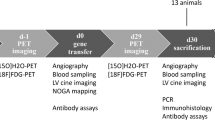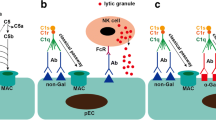Abstract
Objectives: Concordant cardiac xenografts are known for delayed vascular rejection. Therapy combining with FK506 and cobra venom factor prolongs graft survival. The proposed underlying mechanism holds that cytoprotective proteins such as Bcl-2 play a role here. We studied the effects of gene transfection of human-bcl-2 on graft survival and coronary artery lesions in concordant cardiac xenografts, and discuss the role of cytoprotective genes in vascular xenograft rejection.Methods: Golden-Syrian-hamster hearts were heterotopically transplanted into Lewis rats given FK506 (1 mg/kg daily) and cobra venom factor (0.2 mg/kg; day 0 and 1) intramuscularly. They were divided into 2 groups—grafts transfected vector with the human-bcl-2 gene (Group-B(+)) and vector without the gene (Group-B(−)) using the HVJ liposome method; 4 or 5 grafts from each group were explanted 1, 2, 3, or 4 weeks and more than 1 month after transplantation and evaluated by H-E, Elastic-Van-Gieson and immunohistochemical staining of Bcl-2. Coronary arterial lesions were examined using a scoring method.Results: Bcl-2 expression in endothelial cells in Group-B(+) was confirmed within 2 weeks after transplantation but not thereafter. The coronary score in Group-B(+) was significantly lower than that in Group-B(−) within 2 weeks after transplantation but not thereafter. Conclusions: In this hamster-to-rat cardiac xenograft model, the bcl-2 gene was successfully transfected to the coronary endothelium and lasted 2 weeks. During Bcl-2 expression, coronary vascular lesions were suppressed more than in the untransfected group.
Similar content being viewed by others
References
Marchman W, Araneda D, DeMasi R, Taylor D, Larkin E, Alqaisi M, et al. Prolongation of xenograft survival after combination therapy with 15-deoxyspergualin and total-lymphoid irradiation in the hamster-to-rat cardiac xenograft model. Transplantation 1992; 53: 30–4.
Xiao F, Chong AS, Foster P, Sankary H, McChesney L, Koukoulis G, et al. Leflunomide controls rejection in hamster-to-rat cardiac xenografts. Transplantation 1994; 58: 828–34.
Bach FH, Ferran C, Hechenleitner P, Mark W, Koyamada N, Miyatake T, et al. Accommodation of vasculatized xenografts: expression of “protective genes” by donor endothelial cells in a host Th2 cytokine environment. Nat Med 1997; 3: 196–204.
Fukushima N, Ohtake S, Yamaguchi T, Kobayashi Y, Yoshitatsu M, Ahmet I, et al. Role of endothelial apoptosis in delayed xenograft rejection in pig-to-baboon cardiac transplantation. Transplant Proc 1999; 31: 2731–2.
Sawa Y, Kaneda Y, Bai HZ, Suzuki K, Fujimoto J, Morishita R, et al. Efficient transfer of oligonucleotides and plasmid DNA into the whole heart through the coronary artery. Gene Ther 1998; 5: 1472–80.
Ono K, Lindsey ES, Improved technique of heart transplantation in rats. J Thorac Cardiovasc Surg 1969; 57: 225–9.
Suzuki K, Sawa Y, Ichikawa H, Kaneda Y, Matsuda H. Myocardial protection with endogenous overexpression of manganese superoxide dismutase. Ann Thorac Surg 1999; 68: 1266–71.
Kawahira Y, Sawa Y, Nishimura M, Sakakida S, Ueda H, Kaneda Y, et al. Gene transfection of beta 2-adrenergic receptor into the normal rat heart enhances cardiac response to beta-adrenergic agonist. J Thorac Cardiovasc Surg 1999; 118: 446–51.
Taylor MF, Woolveridge I, Metcalfe AD, Strueli CH. Leydig cell apoptosis in the rat testes after administration of the cytotoxin ethane dimethanesulphonate: role of the Bcl-2 family members. J Endocrinol 1998; 157; 317–26.
Hsu SM, Raine L, Fanger H. Use of avidin-biotinperoxidase complex (ABC) in Immunoperoxidase techniques: a comparison between ABC and unlabeled antibody (PAP) procedures. J Histochem Cytochem 1981; 29: 577–80.
Lurie KG, Billingham ME, Jamineson SW, Harrison DC, Reitz BA. Pathogenesis and prevention of graft arteriosclerosis in an experimental heart transplant model. Transplantation 1981; 31: 41.
Lin Y, Soares MP, Sato K, Csizmadia E, Robson SC, Smith N, et al. Long-term survival of hamster hearts in presensitized rats. J Immunol. 2000; 164: 4883–92.
Author information
Authors and Affiliations
Rights and permissions
About this article
Cite this article
Kobayashi, Y., Fukushima, N., Sawa, Y. et al. Effects of gene transfection of human bcl-2 on concordant cardiac xenografts in hamster to rat model. Jpn J Thorac Cardiovasc Surg 49, 570–575 (2001). https://doi.org/10.1007/BF02913534
Received:
Accepted:
Published:
Issue Date:
DOI: https://doi.org/10.1007/BF02913534




